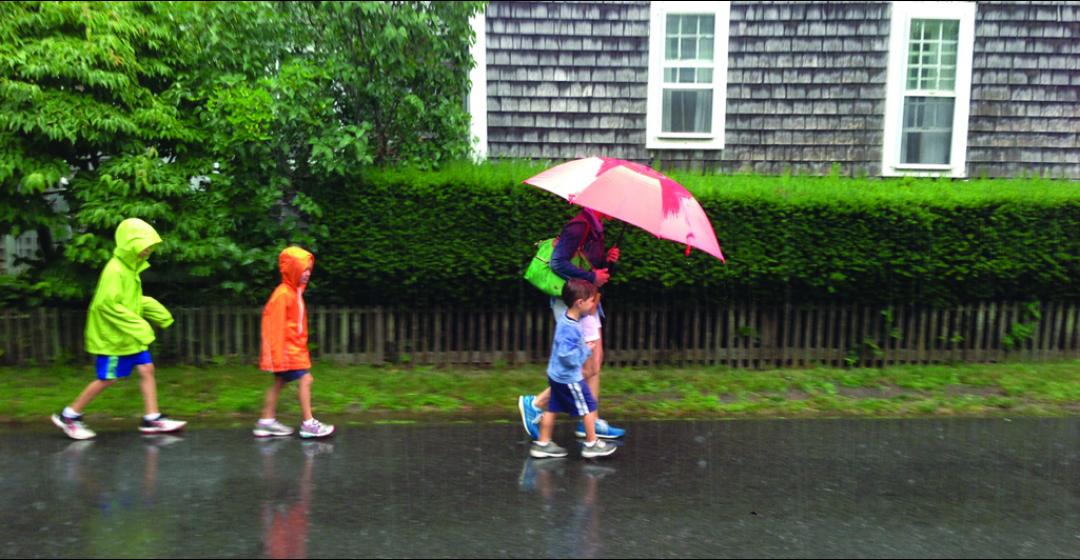Farewell, summer. Hello, Vineyard fall. For many, it is the most cherished of Island seasons. The crowds thin out, the parking spots return, and the beaches are ours for the (dog-)walking. Of course, this drop in tourists implies a drop in temperature, and with it, a rise in precipitation. Whether strolling through a light autumn rain or swell-hunting in a full-fledged hurricane, no wet-weather wardrobe would be complete without a version of the classic yellow (or orange) rain slicker.
For centuries, sea merchants and fishermen from the coasts of England to Australia have been finding creative ways to stay dry on the stormy seas. By the early nineteenth century, it was common practice for sailors to repurpose old sail cloths which, when treated with a particular blend of linseed oil and wax, would become virtually waterproof. Over time, these “oilskins” took on a yellowish hue, due to the wearing of the cloth and the oil used to treat them, and were, perhaps, the original forebears of today’s popular brightly colored raincoats.
By the turn of the twentieth century, two oilskin manufacturers had gained popularity in Europe: Helly Hansen, started in 1877 by a Norwegian sea captain and his wife, and Grundens, run by a fisherman’s son on the inclement shores of the Swedish west coast. Both brands remain beloved by the seafaring set today, although, thanks to much experimentation with material and process, modern versions differ substantially from their early counterparts. And yet the bright colors endure.
Oilskins were practical and durable for life at sea, but as the trend moved mainland, a more fashionable, wearable option was preferred. While the indigenous people of the Amazon had been waterproofing footwear and fabrics by extracting a milky substance from Para rubber trees for hundreds of years, it wasn’t until 1823 that the worlds of rubber and fashion officially collided.
Charles R. Macintosh, a Scottish chemist, discovered while experimenting with a byproduct of coal-tar called naptha that when combined with India rubber and applied to two thicknesses of cloth, the resulting material was completely water-tight. Macintosh founded his company, Charles Macintosh and Co., and began producing waterproof versions of the classic British riding coat, which the waterlogged citizens of the UK and beyond took to like . . . well, like the eternally-rained-on in search of proper protection.
Soon demand for the “Macs” was too much for Macintosh to meet alone. In 1830, Macintosh merged with English manufacturing engineer Thomas Hancock. Hancock, long thought to be the founder of the British rubber industry, had been experimenting with various rubber treatment techniques, and together the two men produced superior slickers using updated equipment and improved methods of manufacturing rubberized cloth.
Throughout the twentieth century, “Macs” or “Macks” (the “k” was added erroneously by writers, yet was so persistent that the Mackintosh brand of today had no choice but to add it on; it’s now the official name) grew to become synonymous with “raincoat.”
With advancements in technology and the introduction of new synthetic materials, from polyurethane (PU) to polyvinyl chloride (PVC) to the outdoorsman’s favorite, Gore-Tex, the raincoat has seen many changes. Even the original Mackintosh has been updated for the twenty-first century, and recent collaborations with high-fashion designers from Gucci to Louis Vuitton have yielded trendier styles and sleeker silhouettes.
But the most iconic rain-day raiment remains the bright classic slicker, worn and beloved by soggy-weather soldiers, from the Gorton’s fisherman to our very own Menemsha anglers, braving the stormy seas in rain or . . . more rain.
 Find them around town
Find them around town
Woolrich, Men’s Classic Waterproof Rain Slicker
For the fashion-forward purist, this staple combines elements of the original slicker with clean lines and breathability. Available at Backwater Trading Company in Edgartown, $115.
Grundens, GAGE Storm Runner Jacket
At Sun Dog in Edgartown, the best-selling raincoat is a hooded, waist-length version of the classic slicker, offered in “High Visibility Yellow.” $62.
For full-body coverage, shop like a fisherman at Menemsha Texaco, where Grunden jackets (pictured at left) and bib pants are sold for $109 apiece.
Outback Trading Company, Pak-A-Roo
Another favorite at Sun Dog is the Pak-A-Roo, a lightweight, waterproof, floor-length coat that folds into its very own backpack. Available in yellow and navy for $105.





